I was hanging out with some readers on facebook last week and one of them asked, “What’s an envelope system?” I searched for a link to my blog post all about envelope systems and you know what? I never wrote one! I talk about them here and there, but didn’t cover the basics in much detail.
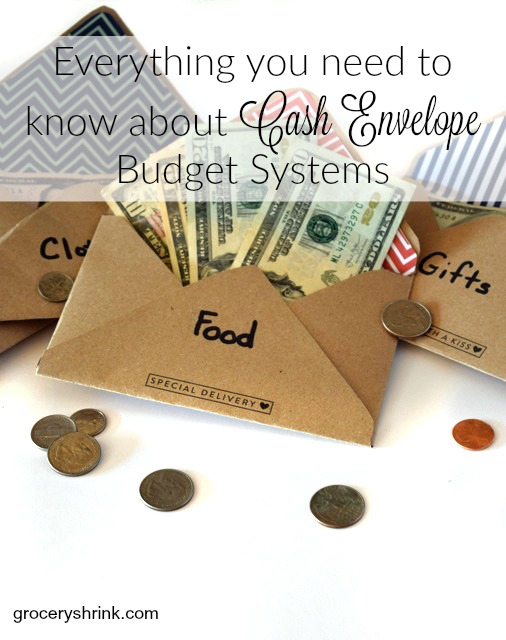
An envelope system is a cash system that makes sticking to a budget so easy a kid can do it. Basic envelope systems have an envelope for each budget category with cash in it. Some families refill the envelopes every two weeks. We prefer to fill them one month at a time. If you are living paycheck to paycheck, I recommend budgeting for each pay period.
However you do it, there are TWO important rules to follow:
- Don’t move cash from one category to another one without checking in with your accountability partner (your spouse if you have one.)
- When you are out of cash, you can’t spend any more in that category until the next budget period.
Dave Ramsey includes envelopes for budgeting in his Financial Peace University kits, but any envelope will do. If you want cute ones for cheap, you can print these and glue them together like I did for the photo.
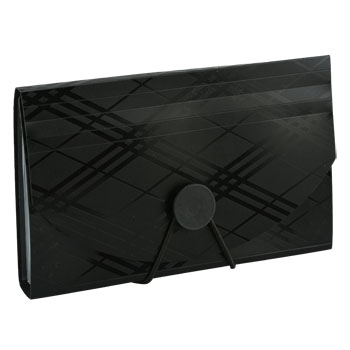
Dollar Tree 7 Category Coupon Organizer
I don’t like using paper envelopes because it takes extra time to open each flap and get money out. I’m often spending from more than one category at a store, so I prefer using a checkbook size coupon organizer that allows me to access all my categories at once. They are available for $1 at Dollar Tree or the Target Dollar Spot. The main downfall of these coupon organizers is their holey bottoms. They work great for keeping bills together, but coins won’t stay in their proper slot. I don’t worry about it and use loose change when it makes sense (like to give exact change to the cashier or for late month ice cream runs.) If this bothers you, there are more secure options.
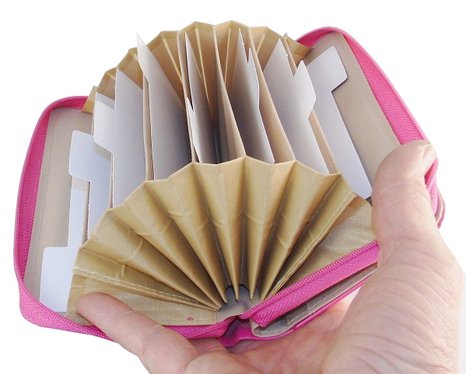
Sturdy wallet options include: the 8 category Buxton Ultimate Shopper, available in pink, black or cheetah for around $10. I don’t have this one personally, but it looks like the change might float in this one also. BUT it has a zipper which will keep it from ending up in the bottom of your purse.
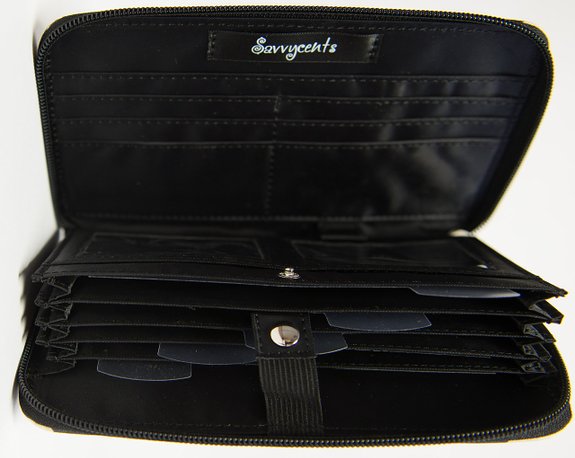
Or the 5 category Savvy Cents Wallet available in 7 colors for $32.95. This one has a zipper change pocket in the back.
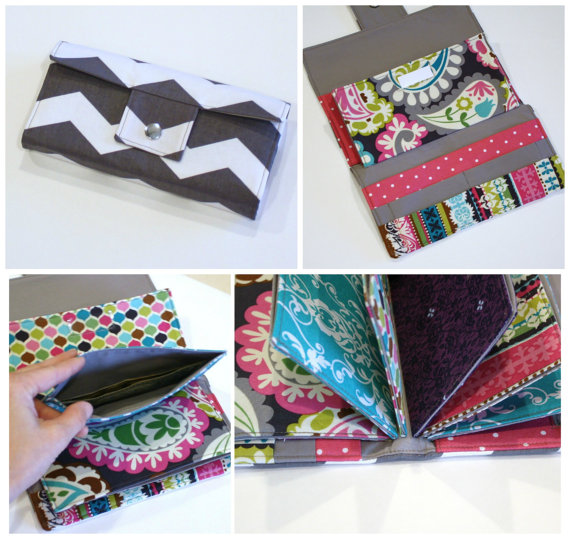
Etsy also has some cottage made versions including this $5 sewing pattern for those of you who love to DIY.
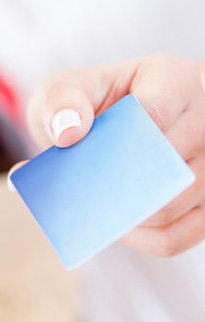
We don’t use cash for every category in our budget, only the ones that are easy to overdo. For example, we use a debit card to buy gas for the car. It would be a pain to take all the kids out of the car to walk into the store to pay every time we buy gas. On our road trip to Colorado last summer we ran across some gas stations that gave a discount for using cash. We made the effort to walk in and pay at those shops. We also don’t use cash for the electric bill, natural gas bill, insurance payments or our mortgage. Those are all paid by direct bank transfer.
I have a Target Red Card (debit card) that I use for all my Target purchases. It gives me an additional 5% off plus free shipping when shopping online. When I use my debit card to shop from a category we’ve designated for cash, I immediately pull the cash out of the corresponding envelope and move it to an envelope to go back to the bank. We generally hold this “bank” envelope until the following month and use it to restock our envelope system. The exception is if we start to get low in the checking account I go ahead and deposit the cash to prevent an overdraft.
Benefits of an envelope system:
- You can see at a glance how much money you have left in each category.
- It prevents checking overdrafts.
- There’s no huge credit card bill to pay off at the end of the month.
- If you forget to write it down, you can still see how much money you have left.
Downsides of an envelope system:
- There’s no record like with a credit card. So you’ll know the money is gone, but you might not remember what you spent it on. (We keep our receipts and record them into Quicken as an extra accountability step. If I weren’t married to a CPA I’d SKIP this step, but it’s really important to him.)
- Risk of theft. In the 11 years of living with an envelope system I’ve only be stolen from 1 time. It was sad and a good lesson for me to keep a better eye on my stuff. Some people hedge against the risk by only taking a small portion of their budget with them when they shop.
Tips for making the envelope system work for you:
- Let each spouse have his own set of envelopes, based on the spending they typically do. For example, I keep most of the grocery money, the clothing money, and the gift money. While Darren keeps the date night money and a lunch envelope for buying his lunch groceries that he keeps at the office.
- Get some small bills so you can make change for yourself if buying from multiple categories.
- Make a new budget every month. It can be based on the previous budget but you should make changes based on real life. Are you throwing a birthday party this month? Budget it. Did the electric bill go up because you had to turn on the air conditioner, change it in the budget. Is it time to buy half a cow or stock up on 50 pound bags of grain? You get the idea.
Let’s keep the discussion going. Do you use an envelope system? Put your tips or questions in the comments.
For more advice on starting a budget from scratch, try Create Your Monthly Budget
I really like the idea of an envelope system and I tried it, physically putting cash in a series of envelopes. It was effective in helping control my spending, but was too cumbersome for me to actually keep doing. I discovered an online program called YNAB (You Need A Budget) that works on the same principle but uses categories instead of envelopes. I particularly like that there is also a record of past transactions and the program is accessible at the point of purchase if you have a smart phone. Just as with the physical envelopes, you have to be committed to staying within the money available in each category. I volunteer with a nonprofit that works with single moms, and I help them learn to manage their money. I tried using the physical envelope system with them, but they found it all too easy to take cash from another envelope when they ran out, and it was a nightmare trying to keep up with receipts to figure out where the money went. I switched them over to YNAB and encouraged them to use a debit card so it was easy to track, and it works much better. The best thing is to be able to look back over a month’s time to see where they spent what – usually a real shocker to them. (I am not affiliated with YNAB, just love their program.)
I don’t use the envelope system, but I try to use the same mentality with my card, I have 1000 kronor/week for food (I live in Sweden, we have 25% taxes on food) and then I stretch those money for that week. If I would “borrow” money from next week – that week will be really hard for us. I started this system this month and sofar it’s working out fine, I have a better idea where my money needs to go. I used to register each krona before but I don’t have time for that now when I work more.
I find the envelope system extremely helpful for food. That’s my one cash envelope. It’s waaay to easy to buy a lot of food.
I just started using the envelope system and I found a coupon organizer at Staples that has 6 slots and a little notepad attached to the inside and a place for a pen or pencil. It is also closed at the bottom so change doesn’t slide around on the bottom. So far it works GREAT!!! Thanks for the great post!
Maria, That sounds awesome! I’ll have to go check it out.